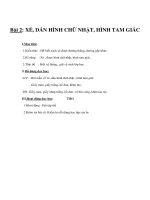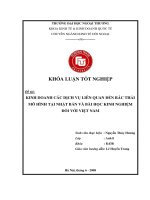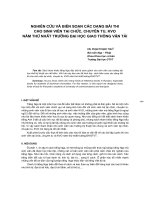Bài psychology opinion essay được nhiều lượt tải nhất
Bạn đang xem bản rút gọn của tài liệu. Xem và tải ngay bản đầy đủ của tài liệu tại đây (81.18 KB, 6 trang )
Fad Diets: Lifestyle Promises and
Health Challenges
Since 1980 the number of people suffering from obesity has doubled
on a worldwide level. According to the latest figures published by
World Health Organisation (WHO) (2015) almost 2 billion adults
(39%) were overweight (Body Mass Index, BMI≥25kg/m2 ), with 600
million of these (13%) being obese (BMI≥30kg/m2 ). Both being
overweight and obese is characterised by excess fat mass in the
body (WHO, 2015). The main factors causing obesity involve
excessive calorie intake, unhealthy eating habits like consuming
processed food, sedentary lifestyle, but also medical conditions
(hypothyroidism) or genetics such as the Prader-Willi syndrome
(National Health Services [NHS], 2014a). There is plenty of evidence
showing that obesity is one of the major public health threats also to
the UK; according to NHS statistics in 2011, 65% of men and 58% of
women over 16 years old are overweight or obese (Health and Social
Care Information Centre [HSCIC], 2013). These figures pose a threat
to the society, which can be translated into non-communicable
diseases, morbidity and mortality if not treated, with a high
economic burden to NHS. There is no doubt that obesity can lead to
various health problems. Common public health consequences
associated
with
abnormal fat deposits
include cardiovascular
diseases, especially heart attack and stroke, diabetes, cancer as well
as musculoskeletal disorders, mainly osteoarthritis (Weight-control
Information Network [WIN], 2014; WHO, 2015). On the other hand,
the mechanical stress induced by obesity can result in disabilities
caused by several conditions such as shortness of breath, sleep
apnoea, osteoarthritis and low back pain (Visscher & Seidell, 2001).
Given the current trend it seems like government actions to tackle
obesity are failing. No country has managed to show any supporting
evidence for improvements. Policymakers do not seem to be working
quickly to identify those reasons and yet they expect fast outcomes.
Intervention plans based on a broader approach that deals with
agriculture, product manufacture and education might be a starting
point to reverse those trends. Table 1 below shows the complexity of
factors that contribute to obesity interventions failure.
2. Fad Diets As a consequence, people are more susceptible to adopt various fad diets
that claim to aid in losing weight very fast. As stated in CDC's “Healthy Weight – It's
not a diet, It's a lifestyle!” a fad diet is any weight loss plan that promises quick results
and is usually a temporary nutritional change (Centers for Disease Control and
Prevention [CDC], 2014). These diets are considered unhealthy as they provide
individuals with less calories and nutrients. 2.1 History of Fad Diets Fad diets are
known for centuries. Since ancient times, it was reported that Greeks and Romans had
used them; however, at that time it was more about a healthy and active lifestyle. It
was Victorians later who actually adopted fad diets. According to Foxcroft (2011) in
her book „Calories & Corsets: A History of Dieting Over 2 000 Years‟, the word diet
originates from the Greek word diaita, which represents a way of life including mental
and physical health. It was in the 19th century that people started dieting for aesthetic
purposes. One of the most famous dieter of all time was Lord Byron, who in 1820
made the Vinegar and Water Diet very popular (Foxcroft, 2011). A century later, the
Grapefruit Diet was created, where eating grapefruit with each meal was suggested as
part of a low calorie diet plan. Interestingly, the Lucky Strike cigarette company
launched the known Cigarette Diet based on the appetite suppressing effects of
nicotine. Later in 1963, Jean Nidetch
founded Weight Watchers and in 1970 the „sedative‟ Sleeping Beauty Diet became
famous (Rotchford, 2013).
The last few decades, fad diets, such as The Atkins and Dukan Diets, became well
known, based on high-protein
and low-carbohydrate intake (Hughes, 2012). Other examples include the Zone Diet,
suggesting a certain ratio of
fat protein and carbohydrates, the South Beach Diet, which is a lighter version of
Atkins Diet and the Master
Cleanse, a diet based mostly in liquid food (Rotchford, 2013). Figure 1 demonstrates
the most important diets
throughout history.
2.2 How to Identify a Fad Diet
A fad diet is usually described as a weight loss plan that guarantees quick weight loss
and dramatic results with
no much effort. There are various types of fad diets that can be recognized; however,
all of them share some
common characteristics (Bastin, 2004). All fad diets promise fast weight loss (more
than 1 kg a week) without
giving away fatty, rich-in-calories food and without the need to regularly exercise.
Most fad diets limit the range
of food types included in the meal plan and do not reassure a balanced and healthy
diet. They usually propose
„miracle‟ foods that need to be consumed in abnormal quantities and help fat burning
with a minimal effort.
Some focus on consuming large quantities of one food type that could result in
intestinal disturbance, bloating,
bad breath and nutritional imbalances (Bastin, 2004).
Fad diets are usually promoted by „before and after‟ images of successful examples of
people that have followed
the particular diet or by „experts‟ in the field of nutrition. However, no health
warnings about possible
consequences of adopting these fad diets on individuals with chronic diseases are
included in the advertisements.
Most fad diets are usually based in no or limited research and can lead to serious
health impacts (Bastin, 2004).
2.3 Popular Fad Diets
As mentioned before, there is a wide range of proposed fad diets over the last
centuries, which are summarised in
Tables 2 and 3. They can be categorised into several main groups including low-/nocarbohydrate,
high-carbohydrate/high-fibre as well as the liquid formula diets (Bastin, 2004; British
Dietetic Association
[BDA], 2014)
3. Causes Leading to Fad Dieting 3.1 The Effect of Peer Pressure Following a fad diet
is often a result of peer pressure. Peer pressure occurs when people of the same age
influence an individual‟s behaviours and decisions by making the person feeling
uncomfortable, including the way of thinking of themselves, dressing and eating. Peer
pressure originates not only from family and friends but also from the outside
environment (Berry, 1999). Criticism of weight and diet by peer members is
associated particularly with dieting in teenagers (Cattarin & Thompson, 1994). The
ideal body image introduced by peers can lead to feelings of inferiority, low selfesteem and depression. Emotions of guilt and unattractiveness are strongly developed
causing individuals to adopt fad diets to make themselves more likable. These
individuals appear to be obsessed with their appearance, weight and popularity within
their peers that results in inefficient dieting (Berg, 1996).
Furthermore, possible failed attempts to quickly lose weight can lead to depression
and „yo-yo‟ dieting. Extreme weight loss followed by quick weight gain is associated
with many health risk factors such as heart disease, cancer, diabetes, increased in LDL
cholesterol as well as reduced muscle and energy. It is believed that these negative
health impacts are linked with the stress hormone called cortisol (McNight, 2013).
These feelings and continuous dieting can result in unhealthy eating habits, which can
continue over someone‟s lifetime (Berry, 1999). The fear of being fat can also lead to
eating disorders from a young age, such as anorexia nervosa and bulimia. In both
disorders, sufferers show body image distortions and feelings of anxiety and shame
about eating (Human Diseases and Conditions [HDC], 2014). 3.2 The Effect of Media
on Body Image and Self-Esteem Over the last decade, statistics have shown an
increase in people suffering from eating disorders in many societies due to the
continuous value that they put on being thin. In every aspects of someone‟s life, such
as going for shopping, watching television, reading fashion magazines and following
favourite celebrities, the very thin figure is linked with a happy and successful life.
Therefore, thousands of teenagers are exposed to the „ideal‟, unrealistic image of
models, who according to medical standards, try to maintain a 15% below normal
weight and meet the criteria for anorexia (Mirror Mirror Eating Disorders [MMED],
2014). Television, movies and social media are full of diet advertisements about food
supplements, diet programs and in general chemically based ways to lose weight.
Every month new novel diets promise to cause dramatic changes to the appearance of
overweight people; probably due to the fact that all previous diets did not work and
are rather unhealthy (MMED, 2014). The inevitable effects of food advertising on
eating behaviours was studied in elementary-school-aged children which received a
snack after watching a cartoon with either a food advertisement or one about other
products (Harris, Bargh, & Brownell, 2009). The results showed that children
consumed 45% more snacks (28.5 gr) when exposed to the food advertisements than
their controls (19.7 gr) (Harris et al., 2009). Journal of Food
Research Vol. 5, No. 6; 2016 85 Apart from advertisements, television and fashion
magazines also include articles or reports about appearance meaning how to look
perfect, how to be in shape, how to apply makeup or suggestions about clothing.
Magazines are also full of photos that have previously been photo-shopped containing
wrinkle-free faces and fat-free bodies which are idealistic and far from reality
(Education.com, 2014). A study has found that 69% of teenage girls agreed that the
photos in magazines affected their idea of the „ideal‟ body image, while 47% said that
as a result they desired to lose weight (Field, 2000). The frequency of reading
magazine‟s articles about weight loss and diets increases the possibilities of adopting
unhealthy eating and weight control behaviours like skipping meals and fasting,
especially among teenagers (Van den Berg, Neumark-Sztainer, Hannan, & Haines,
2007).
THƠNG TIN LIÊN HỆ:
-------------------------Nếu cịn bất kỳ thắc mắc nào hoặc muốn tìm kiếm thêm nhiều tài liệu ESSAY,
ASSIGNMENT mới mẻ khác của Trung tâm Tri Thức Cộng Đồng,
Liên hệ dịch vụ viết thuê assignment, dịch vụ essay: />Hoặc qua SĐT: 0946 88 33 50 hoặc email: để được giúp đỡ
nhé!









